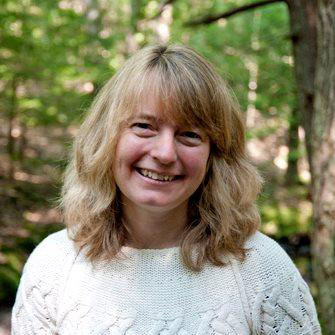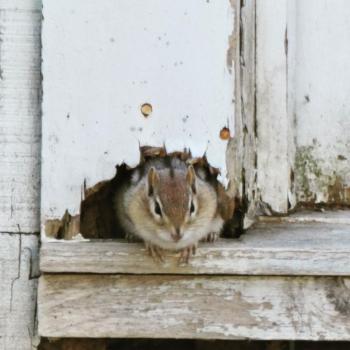Like many, I’ve been spending most of my time for the past couple of months at home. Between Zoom meetings and baking cookies, I’ve tried to get outside as much as possible, even if that means just sitting for an hour on my back porch. All this time hanging out at home has enabled me to get to know my neighbors a little better—at least, the wild ones that share my backyard, who maintain their own social distances.
I’ve been eavesdropping on their conversations, spying on their comings and goings. At any given time of day, from my lawn I can hear three Song Sparrows singing, one near our driveway, one up the road, and one across the street. Three birds, each calling out, in so many words: “This is my space! Males stay away. Females come hither…”
Above the white noise of the Megunticook River, I can also hear the querulous chatter of goldfinches. A few days ago, a pair was eating leaf buds together in a beech tree. The male was patchy, still molting into his bright yellow summer plumage. They won’t nest until July, but they seem to be dating, at least. Sometimes they’re accompanied by another pair. Swingers, maybe?
A pair of House Finches was perched nearby, plucking at crabapple buds. The male’s raspberry-pink head contrasted with the red buds. While he prettily serenaded his presumed mate, I wondered how long it would last. He seems to get around.
Yesterday, in the quiet moments after my neighbor’s lawnmower stopped, I heard a bluebird singing across the river, unusual here in Millville. When we moved into this house 16 years ago, the first bird we saw on the first morning we woke up here was a bluebird, which of course we took as a sign that we’d be happy here. And we have been, so I’ll welcome this one as another good omen. We could certain use one right now.
The familiar voice of the phoebe has been welcome, too, although he returns so early I always feel anxious that he won’t find enough insects to eat. Now that blackflies have appeared, I think I can relax on his behalf. Recently I noted three different phoebes at one time and couldn’t quite figure out who’s being courted and who’s being chased away. With some of these guys it can be kind of a soap opera and just as entertaining to watch.
I’ve been encouraged to hear the first three warblers of the season: the trill of a Yellow-rumped Warbler, the buzz of a Black-throated Green Warbler, and the “squeaky wheel” song of the Black-and-White Warbler. The latter two will stick around now, singing into midsummer, soon to be joined by the chatterbox catbird and the non-stop Red-eyed Vireo.
The cardinal pair, also quite vocal, has been spotted carrying nesting material lately. I think they’re getting ready to settle down.
Although it seems like they’ve just arrived, at least one pair of robins has already settled down. I found a nest in our spruce tree a few days ago, and when I reached my hand inside, was surprised to touch warm eggs! I quickly left so the mother bird could return to them.
Bird nests don’t have a good track record in our busy little yard—we’ve witnessed over the years the sad demise of a nest box of nuthatches, a fledgling Blue Jay, and a nest of American Redstarts—so I don’t hold out a lot of hope for this one. But it’s right outside our back door, so I’ll be able to keep close tabs on it. Robins aren’t quiet, either. Even when I’m inside, I’m attuned to their repeated, agitated squeal that indicates something’s going on back here, be it a fledgling on the ground or a cat passing through the yard. And often the titmice and chickadees will chime in, adding to the din.
The family of seven or eight crows that were constant yard birds through the winter isn’t around as much right now, though I still find their feathers. Presumably some of them are busy nesting. Wherever they’ve gone, they’re sure to materialize, raising a racket, when a hawk passes through. They’re our very own Neighborhood Watch; their loud mobbing has frequently tipped me off to an Osprey or Bald Eagle perched along the river.
We’re probably most intimate with chipmunks. These perky little rodents are basically living with us, having created what must be a complex tunnel system under our house, and shed. I know all their favorite perching spots, and I think they know mine. They chip incessantly; I can now distinguish their two alarm calls: one for terrestrial threats, another for aerial threats. My husband has tried live-trapping and relocating them to no avail. These beady-eyed little buggers continue to taunt us—and our leashed cat—from all corners of the yard, always staying just out of reach.
With time I’m even becoming familiar with the nuances of our trees. The maples were the first to flower, and now the paired leaves are opening, like two hands unclasping. The old white birch has adorned itself with green catkins. The beech leaf buds are long and brown, curving gracefully, catching light. Across the river, a red maple in full flower glows incandescently, brighter somehow on a cloudy day.
And the river itself has been a reassuring presence, a steady voice day and night. After a heavy rainstorm, it became a stranger for a while, draping tattered debris on the bushes, hiding certain rocks, detouring through my neighbor’s yard. Then the freshet calmed, pulled itself together. Ferns and sunny marsh marigolds sprouted up on its banks. A Great Blue Heron sailed in, to perch on a fallen tree.

I can almost tell what time it is now by where sunlight hits the water each afternoon. The alignment of that patch of light with certain trees in the yard is my own makeshift Stonehenge, letting me know when it’s happy hour, when another day of this strange pandemic spring has almost passed.
Kristen Lindquist is an amateur naturalist and published poet who lives in her hometown of Camden.






































